Warning: pic heavy, as usual. 
UPDATE JUNE 24, 2013: I understand from a user here that there are now two versions of this light - the current-controlled sample tested here (without mode memory), and visually-detectable PWM-controlled version (with mode memory). I have not seen the latter version, and have no specifics on its performance or other characteristics.
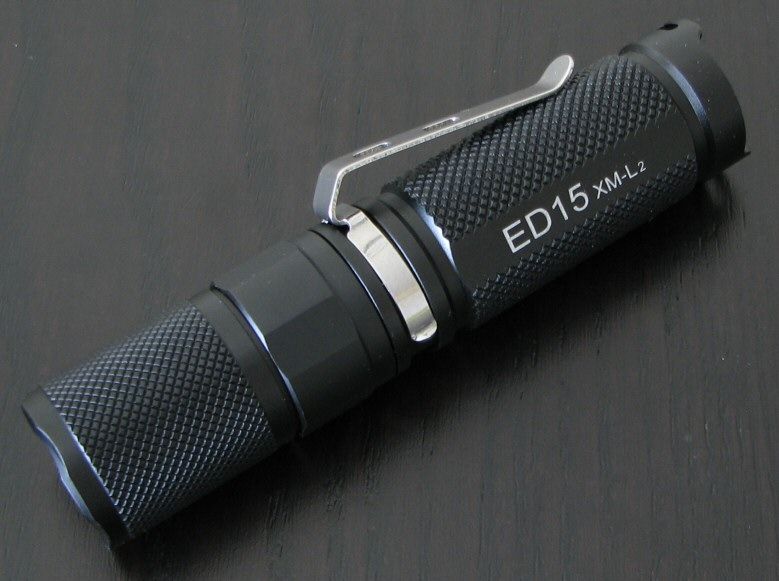
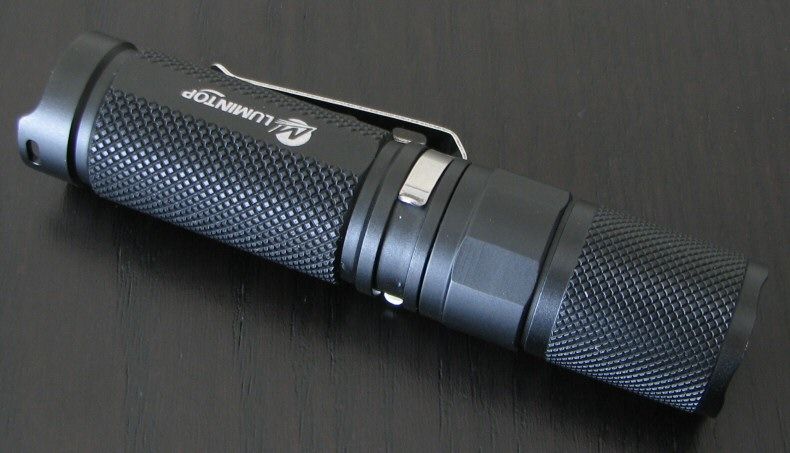
The ED15 is the 1xAA member of the Lumintop ED-series of lights. I reviewed the 1xCR123A/RCR ED11 a few months back. Note the ED15 supports standard AA cells only (i.e., 14500 Li-ion is NOT supported). Let's see how it compares to some others I've reviewed recently …
Manufacturer Reported Specifications:
(note: as always, these are simply what the manufacturer provides – scroll down to see my actual testing results).


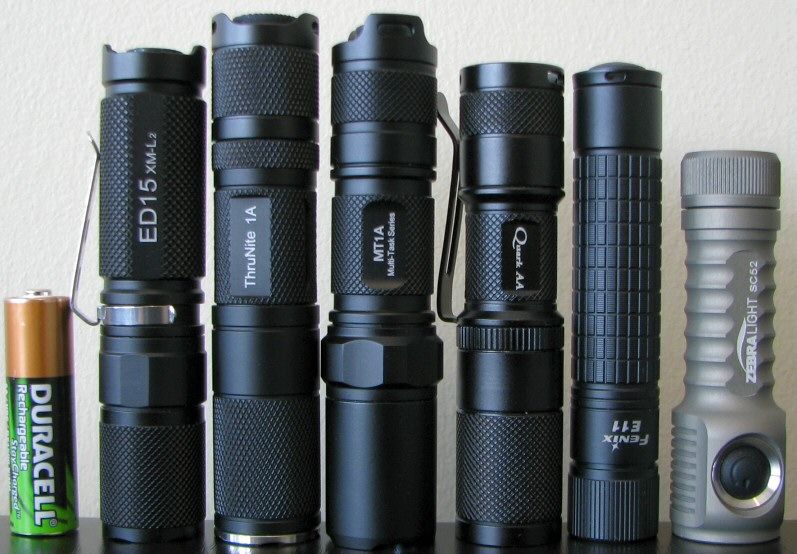
From left to right: Duracell AA NiMH; Lumintop ED15; Thrunite Neutron 1A; Nitecore MT1A; Foursevens Quark QAA; Fenix E11; Zebralight SC52.
All dimensions are given with no batteries installed:
Lumintop ED15: Weight: 59.7g, Length: 100.1mm, Width (bezel): 21.2mm
Zebralight SC52: Weight 39.5g, Length 79.0mm, Width (bezel): 22.6mm, Width (max) 25.4mm
Zebralight SC51: Weight: 37.4g, Length 80.5mm, Width (bezel) 21.1mm, Width (max): 22.6mm
Nitecore MT1A: Weight: 54.6g, Length: 104.6mm, Width (bezel): 22.7mm
Nitecore SENS AA: Weight: 26.1g, Length: 82.7mm, Width (bezel): 19.8mm
Nitecore EZAA: Weight 20.9g, Length: 85.0mm, Width (bezel) 16.6mm
Rofis ER12: Wright: 35.5g, Length: 96.2mm, Width (bezel): 18.6mm
Tiablo E2A: Weight: 45.7g, Length: 101.2mm, Width (bezel): 19.9mm
Xeno E03:: Weight: 48.1g, Length 96.7mm, Width (bezel): 21.5mm
Xtar WK25B: Weight 42.9g, Length: 102.3mm, Width (bezel): 22.5mm
Like the ED11, the ED15 is relatively compact for a 1xAA light with a clicky switch.
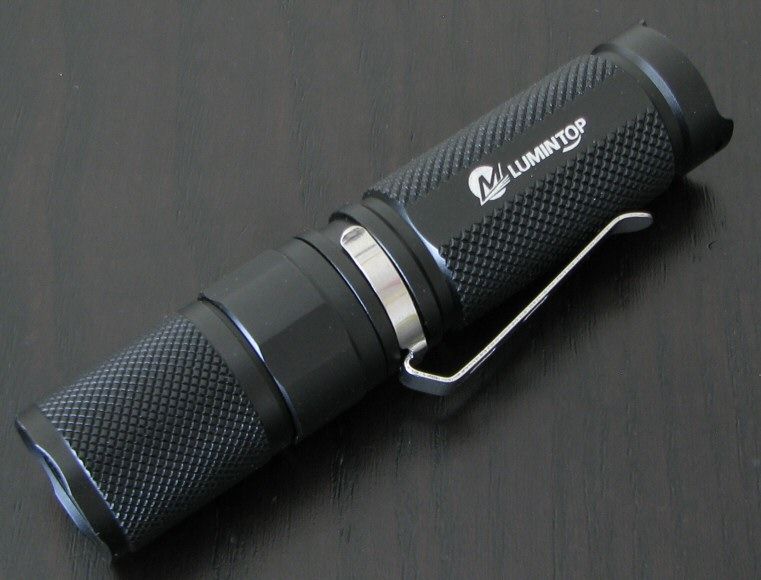
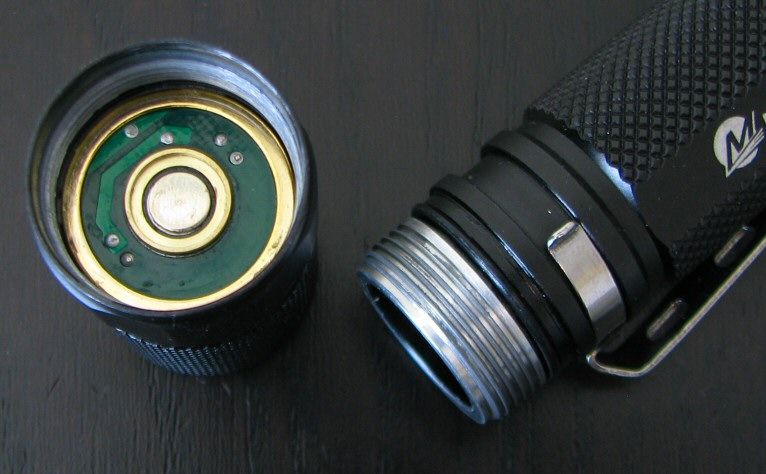
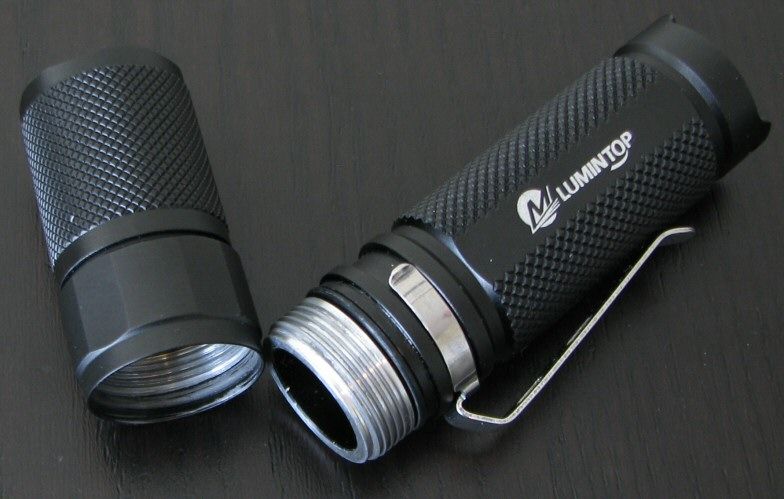

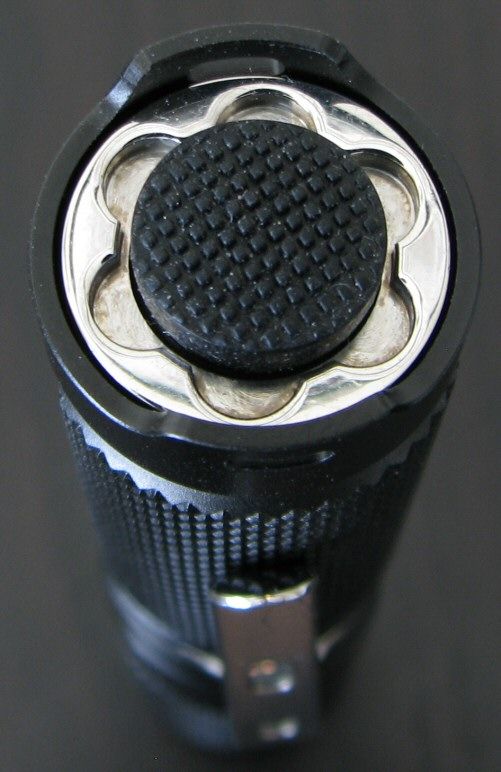
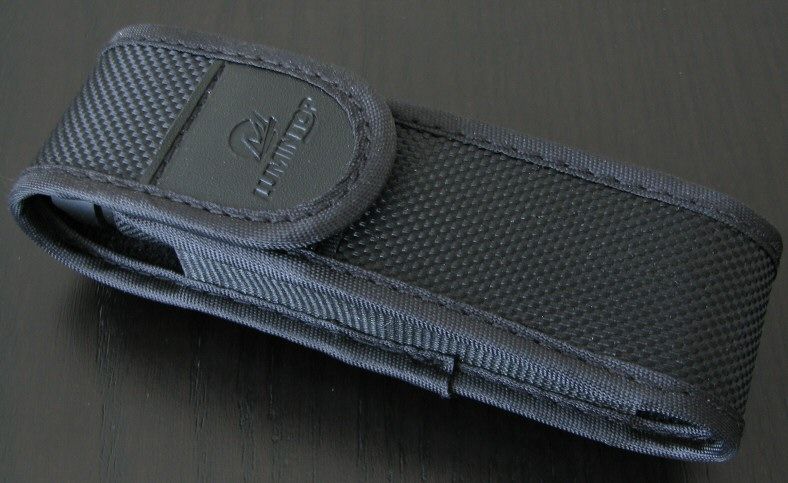
The overall build is fairly solid, with a decent weight for the size. The ED15 features black anodizing (matte finish), with clear white labels. Although it does have a considerable amount of knurling on the head and body, it is not very aggressive. Especially with the pocket clip attached, I'd say grip is good.
On that note, the pocket clip is of the clip-on style, and holds onto the light only as securely as typical for that style. It is reversible, so you carry the light in either orientation (although deep pocket carry isn't really possible).
The tailcap features a reverse-clicky tail switch (i.e., click and release for the light to come on). Reverse clickies are typically low profile, facilitating tailstanding. There is a stylish shiny tailcap retaining ring at the base of the boot cover.
Tailstanding is pretty good on my sample, although there does seem to be a slight instability due to the raised tailcap regions not being very wide. On the plus side, you can easily activate the switch with a thumb or finger, depending on how you plan to carry the light. There are split-ring/lanyard attachment holes on the side of the raised tail cap regions.
Screw threads are standard triangular cut, and are in good shape on my sample. They are not anodized for lock-out, however, given how the interface works (scroll down for an explanation).
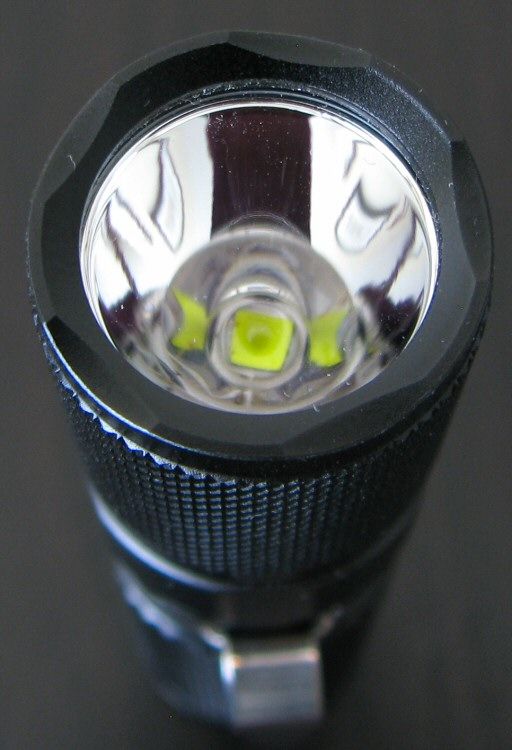
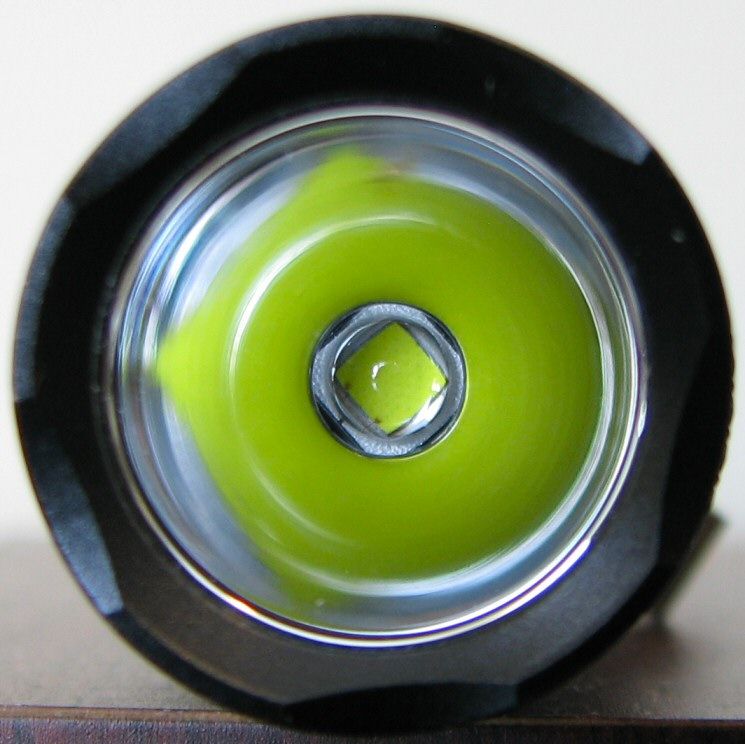
The light has a slightly scalloped bezel, with a relatively smooth reflector. Although smooth, the reflector doesn't seem as shiny as most (i.e., perhaps a very fine texturing). It is also slightly deeper than most lights in this class (but that probably won't enhance throw too much, given its overall size). Cool white XM-L2 T6 emitter was not perfectly centered on my sample, but is not bad.
User Interface
The interface of the ED15 is the same as the ED11. There are three constant output modes and three blinking modes.
Turn the light on/off by the forward tailcap switch. Lightly press and hold for momentary, click (press and release) for constant on. You can advance modes by clicking off-on quickly, or soft-pressing the switch from on (i.e., partial press and release, without a click)
With the head tight against the body, you can access the following constant output modes in sequence from on: Lo > Med > Hi, in repeating loop.
With the head loosened, you can access the following blinking modes in sequence: Fast Strobe > Slow Strobe > Beacon, in repeating loop.
There is no mode memory – the light always comes on in Lo (or Strobe, with head loosened) if you leave it off for more than a few seconds.
Video:
For information on the light, including the build and user interface, please see my video overview:
Video was recorded in 720p, but YouTube typically defaults to 360p. Once the video is running, you can click on the configuration settings icon and select the higher 480p to 720p options. You can also run full-screen.
As with all my videos, I recommend you have annotations turned on. I commonly update the commentary with additional information or clarifications before publicly releasing the video.
PWM
There is no sign of PWM that I can see, at any output level – I presume the light is current-controlled, as with the ED11.
Fast Strobe:

Strobe is a standard "tactical" high frequency strobe, measured at 9.7 Hz.
Slow Strobe:
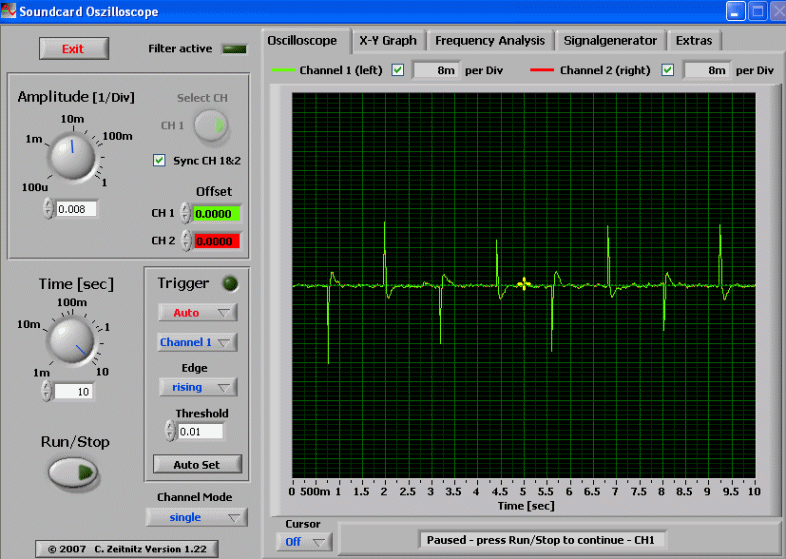
Slow strobe is a one-second On pulse, followed by one-second Off, in repeating sequence
Beacon:
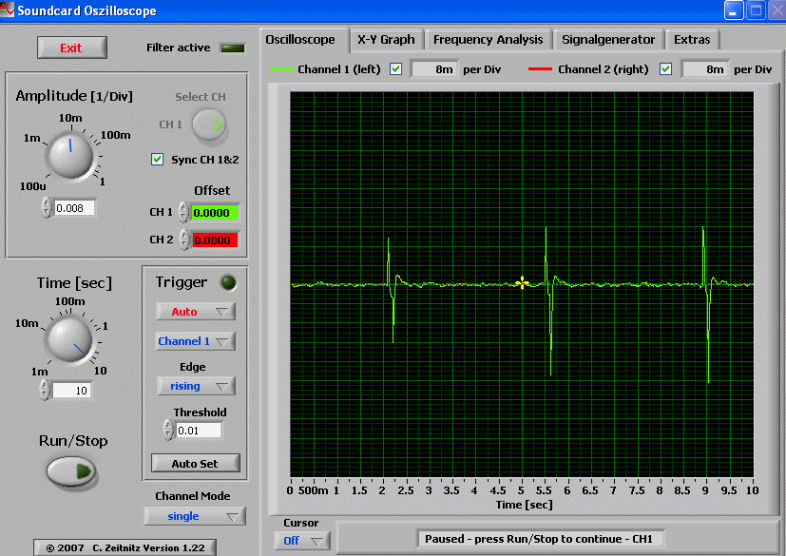
Beacon mode is a quick flash once every ~3.4 seconds.
Beamshots:
All lights are on Max output on Sanyo Eneloop AA NiMH. Lights are about ~0.75 meter from a white wall (with the camera ~1.25 meters back from the wall). Automatic white balance on the camera, to minimize tint differences.

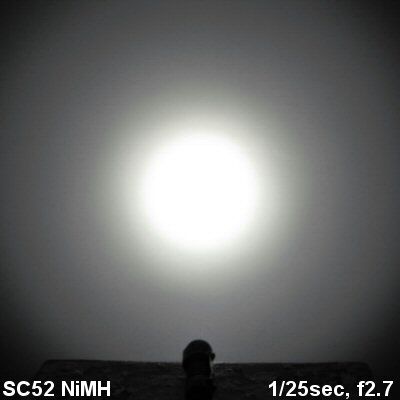
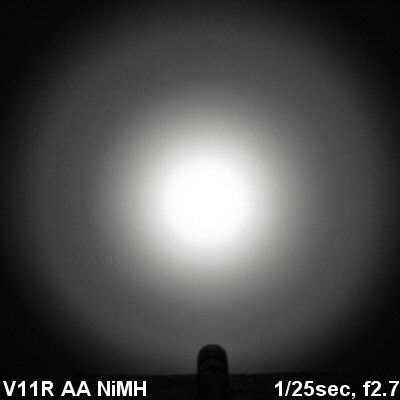
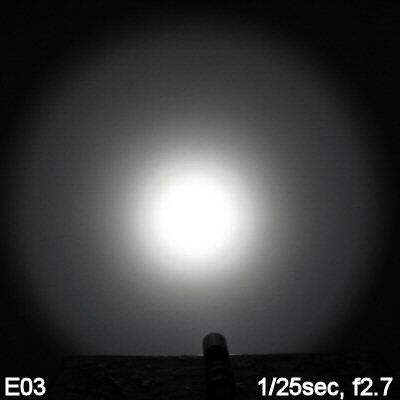
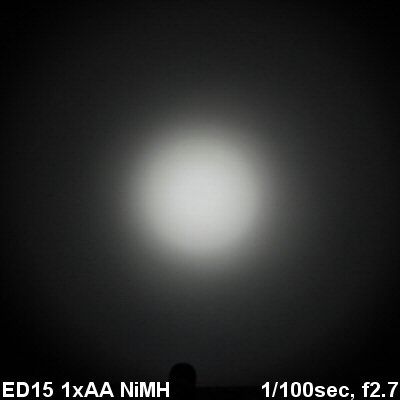
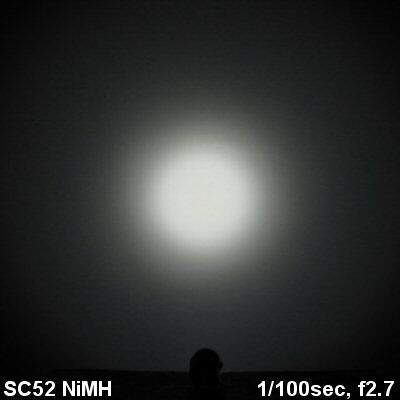
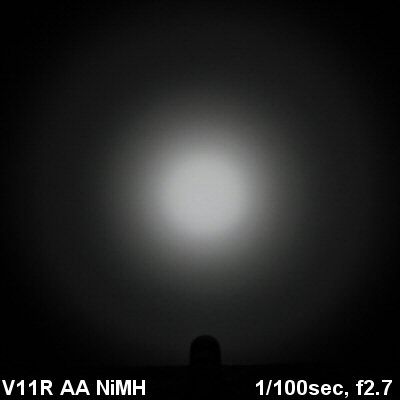
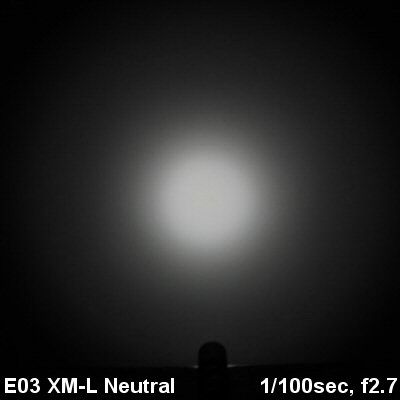
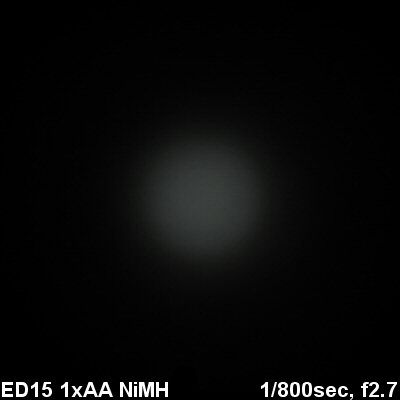
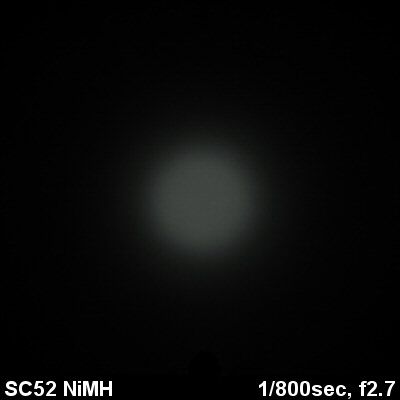
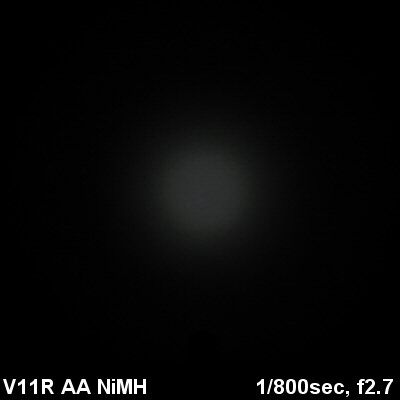
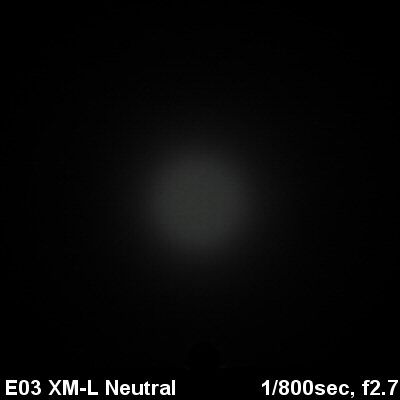

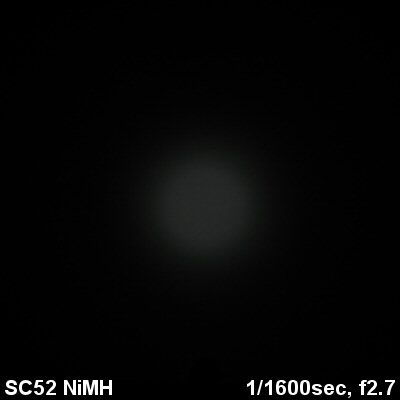
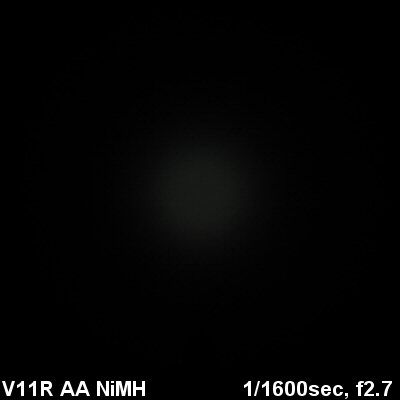
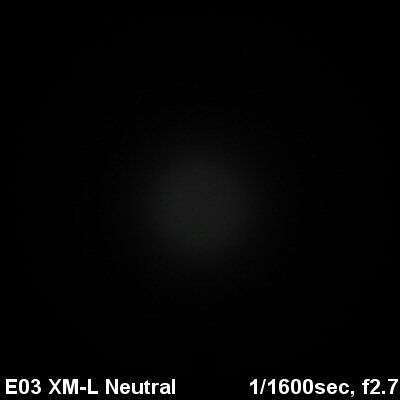
Beam pattern is as you would expect for a XM-L2 light with this size reflector – a fairly big hotspot and decent sized spillbeam. It looks pretty similar to the other XM-L lights shown above. Scroll down for full output details in my tables.
Testing Method:
All my output numbers are relative for my home-made light box setup, a la Quickbeam's flashlightreviews.com method. You can directly compare all my relative output values from different reviews - i.e. an output value of "10" in one graph is the same as "10" in another. All runtimes are done under a cooling fan, except for any extended run Lo/Min modes (i.e. >12 hours) which are done without cooling.
I have devised a method for converting my lightbox relative output values (ROV) to estimated Lumens. See my How to convert Selfbuilt's Lightbox values to Lumens thread for more info.
Throw/Output Summary Chart:
My summary tables are reported in a manner consistent with the ANSI FL-1 standard for flashlight testing. Please see http://www.flashlightreviews.ca/FL1.htm for a discussion, and a description of all the terms used in these tables. Effective July 2012, I have updated all my Peak Intensity/Beam Distance measures with a NIST-certified Extech EA31 lightmeter (orange highlights).

The output is quite good on 1xAA – pretty much the same as my Thrunite Neutron 1A. It is not driven as hard as the recent Zebtralight SC52, though. Similarly, throw is quite reasonable for the output level and size.
What you can't tell above is that there is a timed step-down after 3 mins runtime – see my runtime graphs below for more info.
Note that the ED15 does NOT support 1x14500 Li-ion 3.7V. You are likely to blow the circuit if you try.
As an aside, the XM-L2 T6 emitter used here should perform equivalently to a XM-L U3 (given the change in the output bin numbering).
Output/Runtime Comparison:

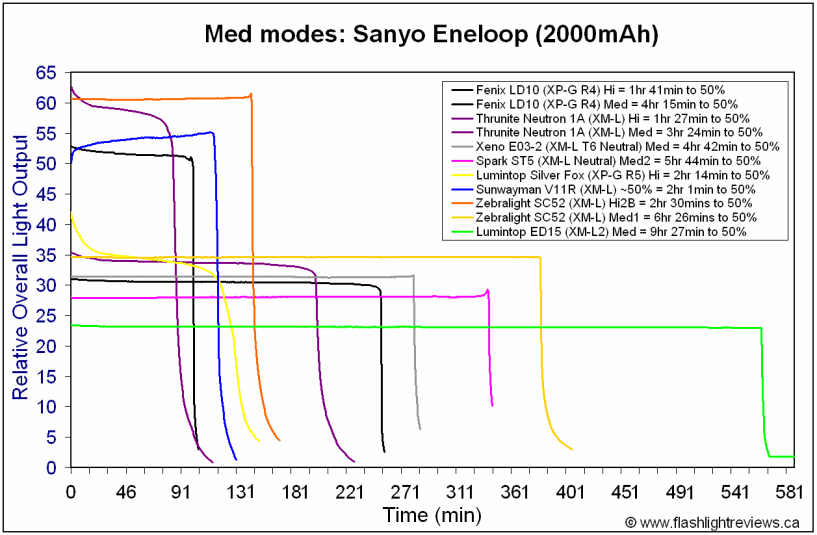
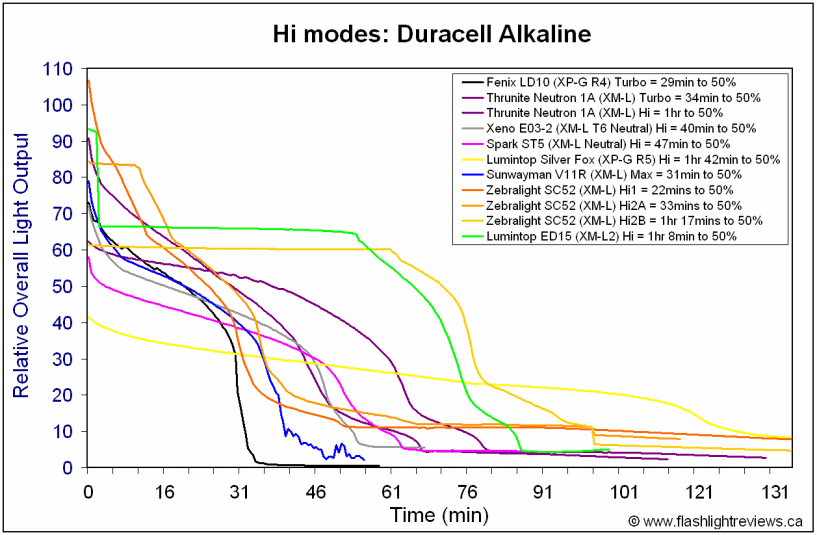
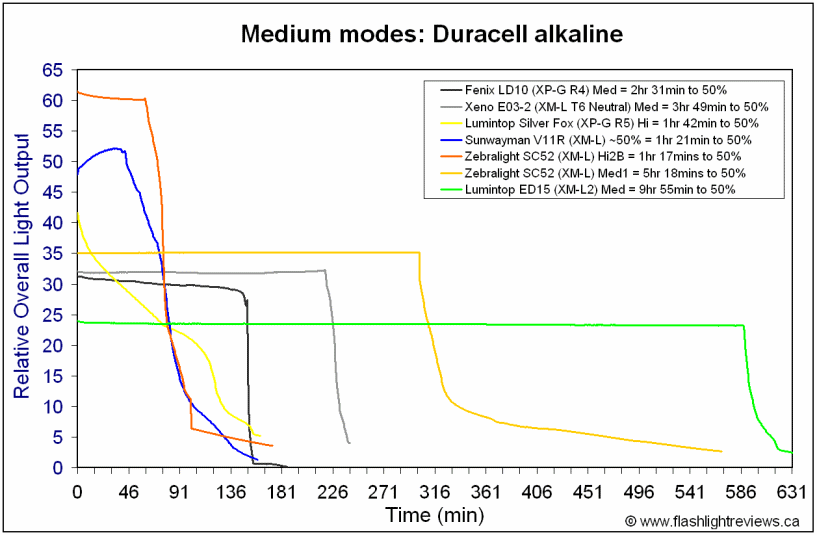
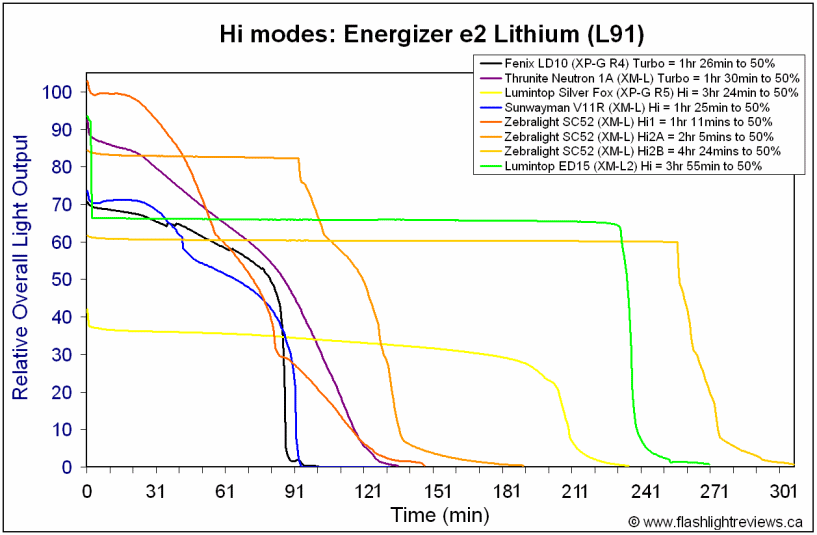
Thanks to the timed step-down at 3 mins, the ED15 has excellent overall regulation and efficiency on Hi. It is also quite a good performer on Med. In fact, overall efficiency and runtime patterns on both levels – on all cells - seems quite similar to my Zebralight SC52, when matched for output.
Not shown above, but I estimate the Med mode to be 30 lumens on NiMH. My estimate are thus very close to the official Lumintop ANSI FL-1 specs.
Potential Issues
Because the selection of output modes is organized by head twist (i.e., head loose vs head tight), no physical lock out is possible (i.e., screw threads can't be anodized). However, the recessed reverse clicky switch should reduce the risk of accidental activation.
1x14500 Li-ion 3.7V are not supported (standard AA cells only).
The light lacks mode memory, and always comes on in Lo (or Strobe, depending on the state of the head twist).
Switch is a reverse clicky, so no momentary mode is possible.
Tailstanding was slightly unstable on my sample, likely due to the small surface area of the raised tailcap ridges.
Preliminary Observations
Like the ED11 (1xCR123A/RCR), the ED15 is a nice little light in the standard 1xAA class. It has a simple yet functional interface, with excellent regulation and output/runtime efficiency for the class.
The light is reasonably compact for a clicky-switch style light, and overall construction seems good. Switch feel is about typical for a reverse clicky. The simple user interface worked well in my testing, and I like that the blinky modes are "hidden" behind a head loosening from the constant output modes. :thumbsup: Some people may have preferred a memory mode, but failing that, I personally like having the Lo mode start found here.
Output and circuit performance is excellent. Like many lights, the ED15 steps down to a lower Hi after 3 mins of continuous runtime. It is not as bright as my Zebralight SC52, but it is in the same general class of most XM-L-based AA-lights (at least initially). Overall regulation and runtime are remarkably similar to the SC52, when matched for output level. It is unfortunate that the ED15 does not support 1x14500, but it does have excellent current-controlled circuity on standard cells, for the 1xAA class.
Output mode spacing is generally good, although some may find the low-lumen Lo mode fairly dim compared to the Med/Hi levels. Beam pattern is very clean, with no artifacts on my sample. Overall pattern is very similar to others in the XM-L class. Note that the XM-L2 T6 emitter used here should perform functionally exactly the same as a XM-L U3.
The ED15 is a nice little AA light, very straight-forward. Worth considering if you plan to use only standard AA cells (i.e., alkaline, NiMH or Energizer L91 lithium). :wave:
UPDATE JUNE 24, 2013: I understand from a user here that there are now two versions of this light - the current-controlled sample tested here (without mode memory), and visually-detectable PWM-controlled version (with mode memory). I have not seen the latter version, and have no specifics on its performance or other characteristics.
----
ED15 was supplied by Lumintop for review.
UPDATE JUNE 24, 2013: I understand from a user here that there are now two versions of this light - the current-controlled sample tested here (without mode memory), and visually-detectable PWM-controlled version (with mode memory). I have not seen the latter version, and have no specifics on its performance or other characteristics.


The ED15 is the 1xAA member of the Lumintop ED-series of lights. I reviewed the 1xCR123A/RCR ED11 a few months back. Note the ED15 supports standard AA cells only (i.e., 14500 Li-ion is NOT supported). Let's see how it compares to some others I've reviewed recently …
Manufacturer Reported Specifications:
(note: as always, these are simply what the manufacturer provides – scroll down to see my actual testing results).
- CREE XM-L2 T6 LED
- HIGH OUTPUT / RUNTIME: 220 lumens / 1.3 hour
- MEDIUM OUTPUT / RUNTIME: 35 lumens / 10 hours
- LOW OUTPUT / RUNTIME: 2 lumens / 100 hours
- BATTERY TYPE: 1×AA
- Function: 2 Ways to Control Dimming System:
- A. Press the tailcap switch ON/OFF to switch between 3 output modes: Low, Medium and High. The light has no memory, so its mode will reset to Low after 2 seconds off.
- B. Loosen the head to switch to Strobe mode. Press the tailcap switch ON/OFF to switch between 3 modes: Strobe, Flash and Slow Flash. The light has no memory, so its mode will reset to Strobe after 2 seconds off.
- LENGTH: 3.9 inches (100.2mm)
- DIAMETER: 0.86 inches (21.9mm)
- WEIGHT: 2.1 ounces (60g)
- MSRP: ~$55



From left to right: Duracell AA NiMH; Lumintop ED15; Thrunite Neutron 1A; Nitecore MT1A; Foursevens Quark QAA; Fenix E11; Zebralight SC52.
All dimensions are given with no batteries installed:
Lumintop ED15: Weight: 59.7g, Length: 100.1mm, Width (bezel): 21.2mm
Zebralight SC52: Weight 39.5g, Length 79.0mm, Width (bezel): 22.6mm, Width (max) 25.4mm
Zebralight SC51: Weight: 37.4g, Length 80.5mm, Width (bezel) 21.1mm, Width (max): 22.6mm
Nitecore MT1A: Weight: 54.6g, Length: 104.6mm, Width (bezel): 22.7mm
Nitecore SENS AA: Weight: 26.1g, Length: 82.7mm, Width (bezel): 19.8mm
Nitecore EZAA: Weight 20.9g, Length: 85.0mm, Width (bezel) 16.6mm
Rofis ER12: Wright: 35.5g, Length: 96.2mm, Width (bezel): 18.6mm
Tiablo E2A: Weight: 45.7g, Length: 101.2mm, Width (bezel): 19.9mm
Xeno E03:: Weight: 48.1g, Length 96.7mm, Width (bezel): 21.5mm
Xtar WK25B: Weight 42.9g, Length: 102.3mm, Width (bezel): 22.5mm
Like the ED11, the ED15 is relatively compact for a 1xAA light with a clicky switch.






The overall build is fairly solid, with a decent weight for the size. The ED15 features black anodizing (matte finish), with clear white labels. Although it does have a considerable amount of knurling on the head and body, it is not very aggressive. Especially with the pocket clip attached, I'd say grip is good.
On that note, the pocket clip is of the clip-on style, and holds onto the light only as securely as typical for that style. It is reversible, so you carry the light in either orientation (although deep pocket carry isn't really possible).
The tailcap features a reverse-clicky tail switch (i.e., click and release for the light to come on). Reverse clickies are typically low profile, facilitating tailstanding. There is a stylish shiny tailcap retaining ring at the base of the boot cover.
Tailstanding is pretty good on my sample, although there does seem to be a slight instability due to the raised tailcap regions not being very wide. On the plus side, you can easily activate the switch with a thumb or finger, depending on how you plan to carry the light. There are split-ring/lanyard attachment holes on the side of the raised tail cap regions.
Screw threads are standard triangular cut, and are in good shape on my sample. They are not anodized for lock-out, however, given how the interface works (scroll down for an explanation).


The light has a slightly scalloped bezel, with a relatively smooth reflector. Although smooth, the reflector doesn't seem as shiny as most (i.e., perhaps a very fine texturing). It is also slightly deeper than most lights in this class (but that probably won't enhance throw too much, given its overall size). Cool white XM-L2 T6 emitter was not perfectly centered on my sample, but is not bad.
User Interface
The interface of the ED15 is the same as the ED11. There are three constant output modes and three blinking modes.
Turn the light on/off by the forward tailcap switch. Lightly press and hold for momentary, click (press and release) for constant on. You can advance modes by clicking off-on quickly, or soft-pressing the switch from on (i.e., partial press and release, without a click)
With the head tight against the body, you can access the following constant output modes in sequence from on: Lo > Med > Hi, in repeating loop.
With the head loosened, you can access the following blinking modes in sequence: Fast Strobe > Slow Strobe > Beacon, in repeating loop.
There is no mode memory – the light always comes on in Lo (or Strobe, with head loosened) if you leave it off for more than a few seconds.
Video:
For information on the light, including the build and user interface, please see my video overview:
Video was recorded in 720p, but YouTube typically defaults to 360p. Once the video is running, you can click on the configuration settings icon and select the higher 480p to 720p options. You can also run full-screen.
As with all my videos, I recommend you have annotations turned on. I commonly update the commentary with additional information or clarifications before publicly releasing the video.
PWM
There is no sign of PWM that I can see, at any output level – I presume the light is current-controlled, as with the ED11.
Fast Strobe:

Strobe is a standard "tactical" high frequency strobe, measured at 9.7 Hz.
Slow Strobe:

Slow strobe is a one-second On pulse, followed by one-second Off, in repeating sequence
Beacon:
Beacon mode is a quick flash once every ~3.4 seconds.
Beamshots:
All lights are on Max output on Sanyo Eneloop AA NiMH. Lights are about ~0.75 meter from a white wall (with the camera ~1.25 meters back from the wall). Automatic white balance on the camera, to minimize tint differences.
















Beam pattern is as you would expect for a XM-L2 light with this size reflector – a fairly big hotspot and decent sized spillbeam. It looks pretty similar to the other XM-L lights shown above. Scroll down for full output details in my tables.
Testing Method:
All my output numbers are relative for my home-made light box setup, a la Quickbeam's flashlightreviews.com method. You can directly compare all my relative output values from different reviews - i.e. an output value of "10" in one graph is the same as "10" in another. All runtimes are done under a cooling fan, except for any extended run Lo/Min modes (i.e. >12 hours) which are done without cooling.
I have devised a method for converting my lightbox relative output values (ROV) to estimated Lumens. See my How to convert Selfbuilt's Lightbox values to Lumens thread for more info.
Throw/Output Summary Chart:
My summary tables are reported in a manner consistent with the ANSI FL-1 standard for flashlight testing. Please see http://www.flashlightreviews.ca/FL1.htm for a discussion, and a description of all the terms used in these tables. Effective July 2012, I have updated all my Peak Intensity/Beam Distance measures with a NIST-certified Extech EA31 lightmeter (orange highlights).

The output is quite good on 1xAA – pretty much the same as my Thrunite Neutron 1A. It is not driven as hard as the recent Zebtralight SC52, though. Similarly, throw is quite reasonable for the output level and size.
What you can't tell above is that there is a timed step-down after 3 mins runtime – see my runtime graphs below for more info.
Note that the ED15 does NOT support 1x14500 Li-ion 3.7V. You are likely to blow the circuit if you try.
As an aside, the XM-L2 T6 emitter used here should perform equivalently to a XM-L U3 (given the change in the output bin numbering).
Output/Runtime Comparison:





Thanks to the timed step-down at 3 mins, the ED15 has excellent overall regulation and efficiency on Hi. It is also quite a good performer on Med. In fact, overall efficiency and runtime patterns on both levels – on all cells - seems quite similar to my Zebralight SC52, when matched for output.
Not shown above, but I estimate the Med mode to be 30 lumens on NiMH. My estimate are thus very close to the official Lumintop ANSI FL-1 specs.
Potential Issues
Because the selection of output modes is organized by head twist (i.e., head loose vs head tight), no physical lock out is possible (i.e., screw threads can't be anodized). However, the recessed reverse clicky switch should reduce the risk of accidental activation.
1x14500 Li-ion 3.7V are not supported (standard AA cells only).
The light lacks mode memory, and always comes on in Lo (or Strobe, depending on the state of the head twist).
Switch is a reverse clicky, so no momentary mode is possible.
Tailstanding was slightly unstable on my sample, likely due to the small surface area of the raised tailcap ridges.
Preliminary Observations
Like the ED11 (1xCR123A/RCR), the ED15 is a nice little light in the standard 1xAA class. It has a simple yet functional interface, with excellent regulation and output/runtime efficiency for the class.
The light is reasonably compact for a clicky-switch style light, and overall construction seems good. Switch feel is about typical for a reverse clicky. The simple user interface worked well in my testing, and I like that the blinky modes are "hidden" behind a head loosening from the constant output modes. :thumbsup: Some people may have preferred a memory mode, but failing that, I personally like having the Lo mode start found here.
Output and circuit performance is excellent. Like many lights, the ED15 steps down to a lower Hi after 3 mins of continuous runtime. It is not as bright as my Zebralight SC52, but it is in the same general class of most XM-L-based AA-lights (at least initially). Overall regulation and runtime are remarkably similar to the SC52, when matched for output level. It is unfortunate that the ED15 does not support 1x14500, but it does have excellent current-controlled circuity on standard cells, for the 1xAA class.
Output mode spacing is generally good, although some may find the low-lumen Lo mode fairly dim compared to the Med/Hi levels. Beam pattern is very clean, with no artifacts on my sample. Overall pattern is very similar to others in the XM-L class. Note that the XM-L2 T6 emitter used here should perform functionally exactly the same as a XM-L U3.
The ED15 is a nice little AA light, very straight-forward. Worth considering if you plan to use only standard AA cells (i.e., alkaline, NiMH or Energizer L91 lithium). :wave:
UPDATE JUNE 24, 2013: I understand from a user here that there are now two versions of this light - the current-controlled sample tested here (without mode memory), and visually-detectable PWM-controlled version (with mode memory). I have not seen the latter version, and have no specifics on its performance or other characteristics.
----
ED15 was supplied by Lumintop for review.
Last edited:


